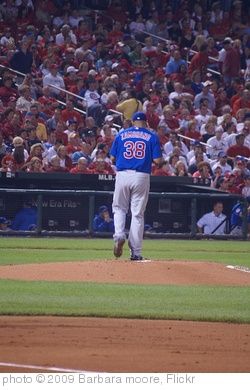 Are you read for it? By “it†I'm referring to the combustible mix that the Marlins have in store for the 2012 season. They added the over-the-top Ozzie Guillen to manage the club, and now they've added the most volatile pitcher in baseball in Carlos Zambrano (for more on Zambrano and his “blow ups†see this Miami Herald piece). Get your bomb shelters stocked with canned goods Marlins' fans.
Are you read for it? By “it†I'm referring to the combustible mix that the Marlins have in store for the 2012 season. They added the over-the-top Ozzie Guillen to manage the club, and now they've added the most volatile pitcher in baseball in Carlos Zambrano (for more on Zambrano and his “blow ups†see this Miami Herald piece). Get your bomb shelters stocked with canned goods Marlins' fans.
The DealCubs Receive: Chris Volstad Marlins Receive: Carlos Zambrano and $15 million*
(*Reports have suggested that number could approach $16 million of the $18 million that Zambrano is due in 2012. Carlos also agreed to waive his $19.25 million option for 2013).
Carlos ZambranoThe Marlins dealt away a legitimate big league arm but got Zambrano back for a few million dollars thanks to the Cubs willingness to pay virtually his whole 2012 salary. Why did the Marlins make the move? “Going back to Ozzie – and I hate to put it all on him – he just feels really comfortable that the kid is going to do well here,†GM Larry Beinfest said. “Ozzie feels very confident in him. He’s confident he can help him.†Can he? It's questionable whether anyone can help Zambrano, but what does Guillen have to work with in Big Z?
From 2003-07 Zambrano threw at least 200-innings each season. That number dipped to 188.2 in 2008, 169.1 in 2009 and then 129.2 in 2010 as his issues started to pile up. He tossed 145.2 innings in the bigs in 2011, and though he has a lot of mileage on his arm, it's pretty shocking to think that he won't be 31 until June. Of bigger concern than his age is the fact that he has lost about two mph off his heater the past couple of seasons. He's still averaging 90 mph on the gun, but he's apparently lost that little extra that made him a bigger strikeout threat.
In 2011 we saw a positive and negative trend with Zambrano . His walk rate was 3.46, a three year best, and more than half a batter better than his 4.05 career mark. Throwing strikes has always been an issue for Zambrano who quite frequently ends up having to leave a start after 5.2 innings because he's already thrown 114 pitches. On the negative side his K/9 rate dropped all the way to 6.24, a batter an a half off his career rate. Is age, wear and tear, lost velocity or poor location to blame? Perhaps all of the above? Amazingly, despite his success over the years, Zambrano's 1.80 K/BB mark last season was the 6th straight year he has failed to post even a mediocre 2.00 K/BB ratio.
Normally able to keep the ball in the yard fairly well, Zambrano was saddled with a 1.17 HR/9 mark last season, the first time in his career that he ever finished a season with a mark over 1.00. He allowed a career-high 37.1 fly ball rate, but that's still a league average rate, so most of the blame deserves to be placed on his 11.3 HR/F rate that was more than his combined totals in 2009 and 2010 (5.6 and 5.2 percent). No one knows for certain, but the assumption is that the new park in Florida will slightly favor the pitcher, so the move down south should benefit Zambrano an allow him to do a better job keeping the ball in the yard.
Zambrano is likely to be healthy enough to take the ball 30 times for the Marlins, and if he does that it's quite possible that he could replicate his 2008 numbers (14 wins, 3.91 ERA, 130 Ks, 1.29 WHIP). At the same time, he has so much to prove to the entire world that you cannot draft him to reach any of those totals. Don't draft Zambrano on name recognition alone, but when your mixed league draft hits the rounds that equate to the legal drinking age in the United States (21 years old for those of you who started drinking at 15) you can begin to ponder adding Zambrano to your roster... that is if you can handle the risk that the pick could blow up in your face.
Chris VolstadThe massive righty, he stands 6'8â€, has a nice skill set to pitch at Wrigley, and by that I mean he keeps the ball down. For his career he owns an impressive 50.4 percent ground ball rate that has led to another strong number in the GB/FB category of 1.61. However, he lacks the pitch to put away batters which means he's much more like Derek Lowe than Felix Hernandez. I'll give Volstad credit, he did post a career best 6.36 K/9 mark last season, a half batter above his career rate, and he also cut his walk rate to a career best level in his fourth season of 2.66 per nine. But the result was still only a slightly better than average 2.39 K/BB ratio. When he gets the ball up in the zone, like most sinker ballers, he has trouble keeping it in the yard (career 1.11 HR/9), but that rate isn't an out of control number.
Given his lack of strikeouts Volstad is more likely to be an asset in NL-only leagues. When he's locked in he is one tough hurler to but the barrel of the bat on, but the fact is that he hasn't shown enough consistency to this point of his career to be anything other than a moderate innings eater at the back of a rotation.
By Ray Flowers

